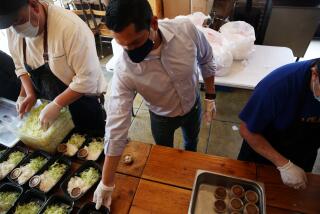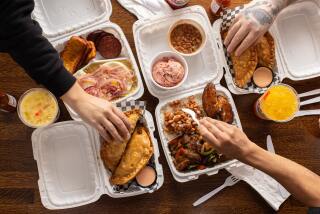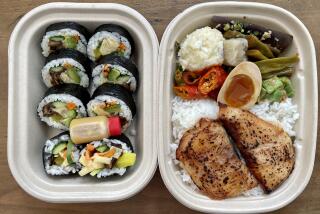Santee Education Complex tries to whet appetite for healthy food
The cafeteria lunch offering at Santee Education Complex on Friday included a sad little hamburger on a bun the color of sawdust, cold sweet potato nuggets and a bag of sliced apples.
I had lunch upstairs, in Bistro Mundo, a small cafe run by Santee’s culinary arts students. Young chefs cooked and served a lovely French omelet, homemade muffins and a tasty salad that included fresh ingredients grown in their own garden near the athletic fields.
The student cooks wore starched white chef jackets, and one of them, 17-year-old Ernesto Calixto, told me over a hot grill that he cooks only with olive oil, because it’s healthier.
“No corn oil,” he said.
My neighbor Melisa Nicola, longtime restaurateur and owner of Nic’s in Beverly Hills, was the one who invited me to Santee. She’s been on a mission to put healthier food options on the table for L.A.’s public school students, partly because of the area’s staggeringly high rates of childhood obesity and diabetes. And she was jazzed about what’s happening at Santee.
As it stands, Bistro Mundo is in a staff lounge smaller than a classroom and open to only adult staff and visitors a couple days a week. Nicola would love to expand the menu to include eight salads, among other offerings, and open the cafe to students as well.
“These kids are amazing,” Nicola had been saying for months, forwarding me essays by Santee students who took a field trip to Archi’s Acres, an Escondido organic farm where military veterans grow and sell produce.
In his essay, Ernesto wrote about the medicinal benefits of farming and healthy eating for vets suffering from post-traumatic stress disorder, as well as about the ins and outs of hydroponic farming. In the classroom kitchen at Santee, he looked like a pro as he flipped an omelet and talked about beating the eggs vigorously to get them light and fluffy.
On Friday, while Ernesto prepared lunch in the classroom kitchen, sophomore Daisy Villanueva and classmates worked up a sweat shoveling rich soil into new garden beds. The kids have been learning about the connection between unhealthy food and heart disease, and the American Heart Assn. donated enough materials to more than double the size of their garden.
“I want to be a farmer and a veterinarian,” said Daisy, who has used what she learned at Santee to plant her own garden at home and raise food to help feed her family.
Pretty interesting, I thought, to see all this enthusiasm about healthy eats, given a recent Times story about the disastrous attempt by L.A. Unified to serve up healthier food in school cafeterias this year. Of course, it could be that some of the new offerings were guaranteed to fail, including Caribbean-sauce meatballs, vegetarian curry and lentil and brown rice cutlets.
“There’s times you eat food and don’t even know what it is,” said Daisy. And the so-called healthy salads in the cafeteria were a turnoff too, in her estimation.
“They were expired,” she said. “The gas from the salad expanded the plastic container, so there was a bubble shape on top.”
Not that it’s easy to serve quality, healthy food five days a week to every one of L.A. Unified’s 700,000 students. And the average teenager, raised on junk food and brainwashed by TV ads for addictive chips, sugar-charged sweets and fast food, is not often heard screaming for low-cal, high-protein, antioxidant options.
But that said, when Ernesto and I ventured into the cafeteria to conduct a quick survey, students who were munching unenthusiastically on uninspired burgers said they’d be willing to try a salad from the school garden if they had the chance.
“I’m not going to be able to break them of their love of Flaming Hot Cheetos,” said Santee Principal Richard Chavez. “But if we can expose the kids to other options, the hope is that they’ll make better decisions.” He also hopes to eventually turn the Santee garden into a community garden, given the limited availability of affordable, quality produce in the South L.A. neighborhood.
Nicola and another volunteer, Lisbeth Caiaffa, have even higher hopes. To them, it’s simple: Better nutrition would knock down disease rates and raise academic scores.
So come on, let’s cut through the bureaucracy and get creative about helping more students prepare and eat healthy food at school, or at least teach them how to do it at home. Nicola was planning to meet with district officials this week to ask for their support.
Caiaffa, a former chef at the Ritz-Carlton in Marina del Rey, seems to be benefiting from her nearly full-time volunteer job at Santee as much as her students benefit from her instruction on nutrition, cooking and the history and culture of food.
“I feel uplifted,” she said about the work, which goes beyond kitchen basics. She’s also a mentor in other ways and tries to offer guidance and discipline to some of the kids who don’t seem to be getting them elsewhere. Sometimes what a student needs more than anything is “a person — someone to talk to, who’s there for them.”
Last weekend, Caiaffa received an urgent email from Ernesto, who had gotten wind of a cooking competition for high school students. He wanted to know if Chef Lisbeth thought he could be a contender.
Yes, she told him. He’s got what it takes.
“I want to be an executive chef,” Ernesto told me in the Santee kitchen, and he may be well on his way.
More to Read
Start your day right
Sign up for Essential California for news, features and recommendations from the L.A. Times and beyond in your inbox six days a week.
You may occasionally receive promotional content from the Los Angeles Times.







